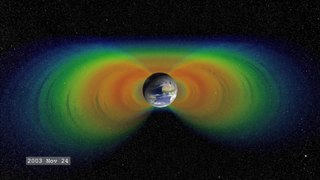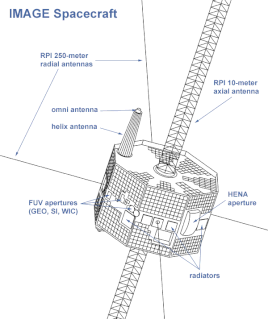
The solar wind is a stream of charged particles released from the upper atmosphere of the Sun, called the corona. This plasma consists of mostly electrons, protons and alpha particles with kinetic energy between 0.5 and 10 keV. Embedded within the solar-wind plasma is the interplanetary magnetic field. The solar wind varies in density, temperature and speed over time and over solar latitude and longitude. Its particles can escape the Sun's gravity because of their high energy resulting from the high temperature of the corona, which in turn is a result of the coronal magnetic field.

An ion thruster or ion drive is a form of electric propulsion used for spacecraft propulsion. It creates thrust by accelerating cations by utilizing electricity. The term refers strictly to gridded electrostatic ion thrusters, and is often incorrectly loosely applied to all electric propulsion systems including electromagnetic plasma thrusters.

A Van Allen radiation belt is a zone of energetic charged particles, most of which originate from the solar wind, that are captured by and held around a planet by that planet's magnetic field. Earth has two such belts and sometimes others may be temporarily created. The discovery of the belts is credited to James Van Allen, and as a result, Earth's belts are known as the Van Allen belts. Earth's two main belts extend from an altitude of about 640 to 58,000 km above the surface in which region radiation levels vary. Most of the particles that form the belts are thought to come from solar wind and other particles by cosmic rays. By trapping the solar wind, the magnetic field deflects those energetic particles and protects the atmosphere from destruction.

Mars 96 was a failed Mars mission launched in 1996 to investigate Mars by the Russian Space Forces and not directly related to the Soviet Mars probe program of the same name. After failure of the second fourth-stage burn, the probe assembly re-entered the Earth's atmosphere, breaking up over a 200-mile long portion of the Pacific Ocean, Chile, and Bolivia. The Mars 96 spacecraft was based on the Phobos probes launched to Mars in 1988. They were of a new design at the time and both ultimately failed. For the Mars 96 mission the designers believed they had corrected the flaws of the Phobos probes, but the value of their improvements was never demonstrated due to the destruction of the probe during the launch phase.

IMAGE is a NASA Medium Explorers mission that studied the global response of the Earth's magnetosphere to changes in the solar wind. It was believed lost but as of August 2018 might be recoverable. It was launched March 25, 2000 by a Delta II rocket from Vandenberg AFB on a two-year mission. Almost six years later, it unexpectedly ceased operations in December 2005 during its extended mission and was declared lost. The spacecraft was part of NASA's Sun-Earth Connections Program, and during its run had over 400 research articles published in peer-reviewed journals using its data. It had special cameras that provided various breakthroughs in understanding the dynamics of plasma around the Earth. The Principal Investigator was Jim Burch of the Southwest Research Institute.
MagBeam is the name given to an ion propulsion system for space travel initially proposed by Professor Robert Winglee of the Earth and Space Sciences Department at the University of Washington for the October 2004 meeting of the NIAC. MagBeam is different from a traditional electrostatic ion thruster in several ways, the primary one being that instead of the fuel and propulsion system being part of the payload craft, they are instead located on a platform held in orbit. It has also been suggested that the technology could be used to reduce the amount of space debris in orbit around Earth.

The Global Geospace Science (GGS) Wind satellite is a NASA science spacecraft launched on November 1, 1994, at 09:31 UTC, from launch pad 17B at Cape Canaveral Air Force Station (CCAFS) in Merritt Island, Florida, aboard a McDonnell Douglas Delta II 7925-10 rocket. Wind was designed and manufactured by Martin Marietta Astro Space Division in East Windsor, New Jersey. The satellite is a spin-stabilized cylindrical satellite with a diameter of 2.4 m and a height of 1.8 m.

An electrically-powered spacecraft propulsion system uses electrical energy to change the velocity of a spacecraft. Most of these kinds of spacecraft propulsion systems work by electrically expelling propellant at high speed, but electrodynamic tethers work by interacting with a planet's magnetic field.

The Global Geospace Science (GGS) Polar satellite was a NASA science spacecraft designed to study the polar magnetosphere and aurorae. It was launched into orbit in February 1996, and continued operations until the program was terminated in April 2008. The spacecraft remains in orbit, though it is now inactive. Polar is the sister ship to GGS Wind.

The Van Allen Probes, formerly known as the Radiation Belt Storm Probes, are two robotic spacecraft being used to study the Van Allen radiation belts that surround Earth. NASA is conducting the Van Allen Probes mission as part of the Living With a Star program. Understanding the radiation belt environment and its variability has important practical applications in the areas of spacecraft operations, spacecraft system design, mission planning and astronaut safety. The probes were launched on 30 August 2012.

The Magnetospheric Multiscale Mission (MMS) is a NASA unpiloted space mission to study the Earth's magnetosphere, using four identical spacecraft flying in a tetrahedral formation. The spacecraft were launched on 13 March 2015 at 02:44 UTC. It is designed to gather information about the microphysics of magnetic reconnection, energetic particle acceleration, and turbulence, processes that occur in many astrophysical plasmas.
Field propulsion is the concept of spacecraft propulsion where no propellant is necessary but instead momentum of the spacecraft is changed by an interaction of the spacecraft with external force fields, such as gravitational and magnetic fields from stars and planets. It is purely speculative and has not yet been demonstrated to be of practical use or theoretically valid.

Energetic neutral atom (ENA) imaging, often described as "seeing with atoms", is a technology used to create global images of otherwise invisible phenomena in the magnetospheres of planets and throughout the heliosphere, even to its outer boundary. This constitutes the far-flung edge of the solar system.

A solar proton event (SPE), or "proton storm", occurs when particles emitted by the Sun become accelerated either close to the Sun during a flare or in interplanetary space by CME shocks. The events can include other nuclei such as helium ions and HZE ions. These particles cause multiple effects. They can penetrate the Earth's magnetic field and cause ionization in the ionosphere. The effect is similar to auroral events, except that protons rather than electrons are involved. Energetic protons are a significant radiation hazard to spacecraft and astronauts.

The Heliophysics Science Division of the Goddard Space Flight Center (NASA) conducts research on the Sun, its extended solar system environment, and interactions of Earth, other planets, small bodies, and interstellar gas with the heliosphere. Division research also encompasses geospace—Earth's uppermost atmosphere, the ionosphere, and the magnetosphere—and the changing environmental conditions throughout the coupled heliosphere.

JEDI, is an instrument on the Juno spacecraft orbiting planet Jupiter. JEDI coordinates with the several other space physics instruments on the Juno spacecraft to characterize and understand the space environment of Jupiter's polar regions, and specifically to understand the generation of Jupiter's powerful aurora. It is part of a suite of instruments to study the magnetosphere of Jupiter. JEDI consists of three identical detectors that use microchannel plates and foil layers to detect the energy, angle, and types of ion within a certain range. It can detect electrons between 40 and 500 keV, and hydrogen and oxygen from a few tens of keV to less than 1000 keV. JEDI uses radiation hardened Application Specific Integrated Circuits (ASIC)s. JEDI was turned on in January 2016 while still en route to Jupiter to also study interplanetary space. JEDI uses solid state detectors (SSD's) to measure the total energy (E) of both the ions and the electrons. The MCP anodes and the SSD arrays are configured to determine the directions of arrivals of the incoming charged particles. The instruments also use fast triple coincidence and optimum shielding to suppress penetrating background radiation and incoming UV foreground.

Waves is an experiment on the Juno spacecraft to study radio and plasma waves. It is part of collection of various types of instruments and experiments on the spacecraft; Waves is oriented towards understanding fields and particles in Jupiter's magnetosphere. Waves is on board the unmanned Juno spacecraft, which was launched in 2011 and arrived at Jupiter in the summer of 2016. The major focus of study for Waves is Jupiter's magnetosphere, which if could be seen from Earth would be about twice the size of a full moon. It has a tear drop shape, and that tail extends away from the Sun by at least 5 AU. The Waves instrument is designed to help understand the interaction between Jupiter's atmosphere, its magnetic field, its magnetosphere, and to understand Jupiter's auroras. It is designed to detect radio frequencies from 50 Hz up to 40,000,000 Hz (40 MHz), and magnetic fields from 50 Hz to 20,000 Hz (20 kHz). It has two main sensors a dipole antenna and a magnetic search coil. The dipole antenna has two whip antenna's that extend 2.8 meters and they are attached to the main body of the spacecraft. This sensor has been compared to a rabbit ears set-top TV antenna. The search coil is overall a mu metal rod 15 cm (6 in) length with a fine copper wire wound 10,000 times around it. There are also two frequency receivers that each cover certain bands. Data handling is done by two radiation hardened systems on a chip. The data handling units are located inside the Juno Radiation Vault. Waves was allocated 410 Mbits of data per science orbit.
The Plasma Instrument for Magnetic Sounding (PIMS) is a Faraday cup based instrument that will fly on board the Europa Clipper orbiter to explore Jupiter's moon Europa. PIMS will measure the plasma that populates Jupiter's magnetosphere and Europa's ionosphere.

The Interstellar Mapping and Acceleration Probe(IMAP) is a heliophysics mission that simultaneously investigates two important and coupled science topics in the heliosphere: the acceleration of energetic particles and interaction of the solar wind with the local interstellar medium. These science topics are coupled because particles accelerated in the inner heliosphere play crucial roles in the outer heliospheric interaction. In 2018, NASA selected an IMAP team led by David J. McComas of Princeton University to implement the mission. The planned launch for IMAP is in October, 2024. The IMAP spacecraft has a science payload of ten instruments and is a simple Sun-pointed spinner in orbit about the Sun-Earth L1 Lagrangian point. IMAP also continuously broadcasts real-time in-situ data that can be used for space weather prediction.
NASA's Solar Terrestrial Probes program (STP) is a series of missions focused on study the Sun-Earth system. It is part of NASA's Heliophysics Science Division within the Science Mission Directorate.





















